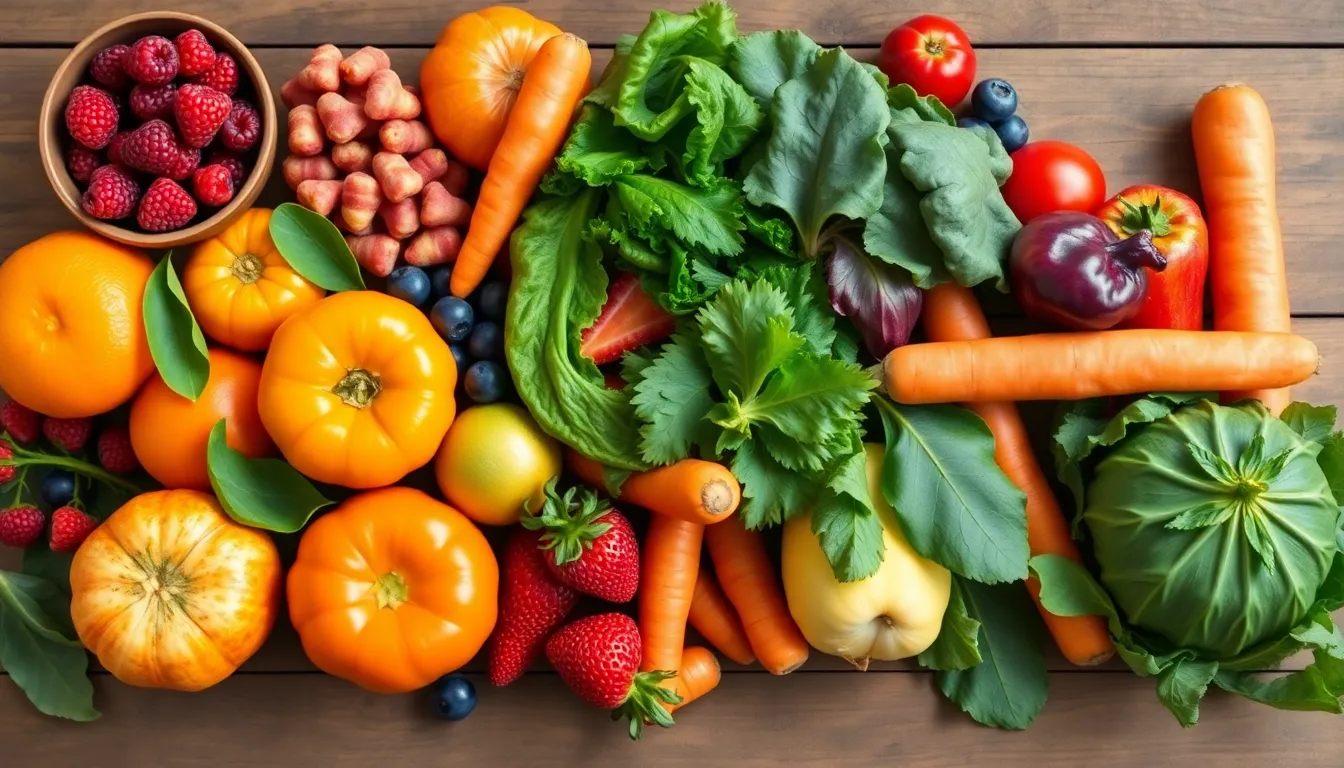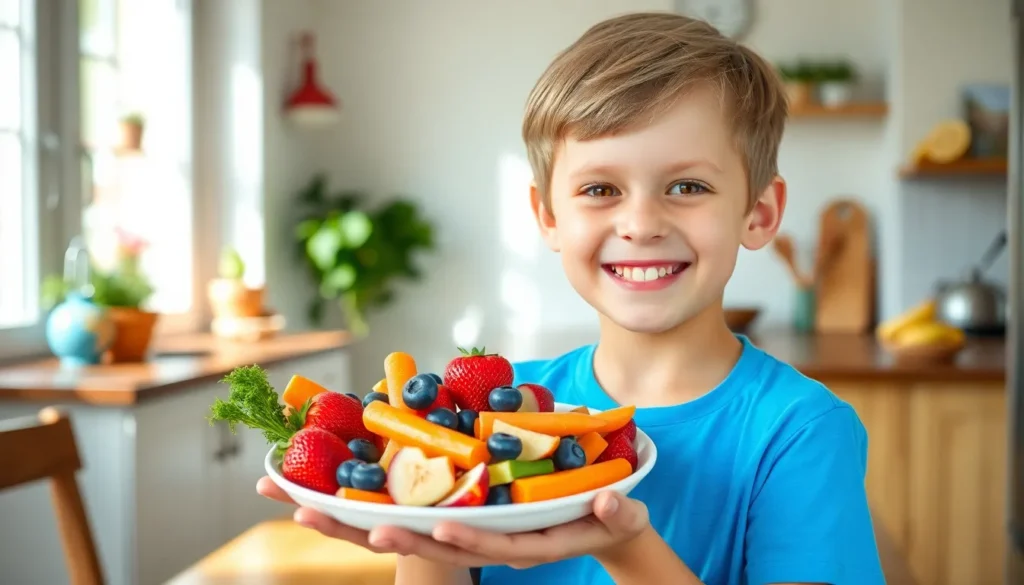Table of Contents
ToggleEvery parent knows that getting kids to eat nutritious food can feel like trying to convince a cat to take a bath. But what if there’s a way to make healthy eating fun and appealing? The secret lies in discovering the best nutrition foods for kids that not only fuel their bodies but also tickle their taste buds.
Understanding Nutrition Needs for Kids
Nutrition needs for kids vary significantly as they grow and develop. Nutrients such as carbohydrates, proteins, fats, vitamins, and minerals play crucial roles in children’s health. Carbohydrates serve as the main energy source, while proteins support growth and repair tissues. Healthy fats assist in brain development and hormone production.
Daily nutritional recommendations guide parents in achieving balanced diets for children. For instance, the USDA suggests that kids aged 2-3 consume around 1,000-1,400 calories daily, with 45-65% from carbohydrates and 10-30% from proteins. Moreover, essential vitamins and minerals like calcium and vitamin D are vital for bone health and growth.
Variety is key in creating appealing meals. Incorporating fruits, vegetables, whole grains, lean proteins, and dairy products fosters nutritional diversity. Parents can encourage healthy eating habits by involving children in meal planning and preparation, making the learning process engaging and fun.
Snack options also matter. Healthy snacks, such as yogurt or fruit, provide nutrients and energy when kids need a boost. Encouraging water consumption over sugary drinks contributes to overall hydration and health.
Regular meals maintain energy levels and support concentration. Ignoring meal times might lead to unhealthy snacking habits, diminishing the nutritional balance. Planning meals ahead often makes it easier for parents to provide nutrient-rich choices.
Understanding nutrition needs must include awareness of food allergies or intolerances. If specific dietary restrictions exist, finding suitable alternatives ensures children receive the nutrients they require without compromising their health.
Top Nutritional Foods for Kids

Choosing the right foods ensures children receive essential nutrients for growth and development. Several food categories play critical roles in achieving a balanced diet.
Fruits and Vegetables
Fruits and vegetables supply vital vitamins and minerals. Incorporating colorful options like berries, oranges, carrots, and leafy greens makes meals more appealing. Vitamins A and C found in these options support immune functions and promote healthy skin. Eating fruits and vegetables regularly can significantly lower the risk of chronic diseases later in life. Parents should aim for at least five servings of fruits and vegetables each day, which can be integrated into snacks and meals seamlessly.
Whole Grains
Whole grains offer important carbohydrates and fiber. Foods like brown rice, whole wheat bread, and oatmeal provide sustained energy, helping children stay focused throughout the day. The fiber found in whole grains aids digestion, supporting a healthy gut. Regular consumption of these grains promotes heart health and may reduce the risk of obesity. Children should consume whole grains as a consistent part of their meals to enjoy maximum nutritional benefits.
Protein Sources
Protein sources are essential for growth, repair, and overall health. Lean meats, poultry, fish, beans, and legumes serve as excellent options. Eggs and low-fat dairy products also provide necessary protein while offering additional nutrients like calcium. Incorporating diverse protein options supports muscle development and boosts energy levels. It’s recommended that children consume a variety of protein sources at each meal to optimize their nutrition.
Healthy Snacks for Kids
Healthy snacks play a vital role in a child’s diet, providing nutrients between meals. Choosing the right snacks helps maintain energy levels and supports growth.
Low-Sugar Options
Opting for low-sugar snacks is essential for children’s health. Fresh fruit, like apples, berries, and bananas, offers natural sweetness without added sugars. Yogurt, especially plain or unsweetened varieties, provides calcium and probiotics. Nuts and seeds deliver healthy fats and protein, keeping children full longer. Whole-grain crackers, paired with cheese, make for satisfying and nutritious options. Air-popped popcorn serves as a great low-calorie treat, especially when seasoned with herbs. These snacks encourage healthier eating habits without compromising taste or satisfaction.
Homemade Snack Ideas
Homemade snacks allow for creative, nutritious options tailored to children’s tastes. Preparing energy bites using oats, nut butter, and honey offers a convenient grab-and-go choice. Fruit smoothies packed with spinach, yogurt, and a banana create a delicious, nutrient-rich beverage. Muffins made from whole grains and filled with fruits or veggies provide a delightful treat. Baking homemade granola bars allows for ingredient control, maximizing nutrition. Lastly, vegetable sticks paired with hummus or guacamole serve as crunchy, flavorful snacks. Each homemade option promotes healthy eating while appealing to kids’ preferences.
Meal Planning Tips for Parents
Meal planning simplifies healthy eating for kids. Parents can ensure balanced nutrition by considering key food groups and varied textures.
Balancing Nutrition
Striking a balance between food groups supports children’s growth and development. Carbohydrates provide energy, while protein fuels muscle growth. Fruits and vegetables offer essential vitamins and minerals. Whole grains enhance digestion and sustain energy levels throughout the day. Incorporating dairy products supplies calcium for strong bones. Parents can aim for a colorful plate filled with different food options. This approach not only satisfies nutritional needs but also keeps meals exciting and appealing to children.
Involving Kids in Choices
Engaging children in food choices fosters a sense of responsibility and encourages healthy eating habits. Letting kids pick fruits or vegetables at the grocery store can spark interest. Preparing meals together also builds excitement around food. Allowing children to select nutritious snacks enhances their investment in what they eat. Presenting food in fun shapes or themes can make eating appealing. This collaborative approach helps children feel empowered while developing a preference for wholesome foods.
Fostering healthy eating habits in children is a rewarding journey that requires creativity and patience. By introducing a variety of nutritious foods and involving kids in meal preparation and choices, parents can make healthy eating enjoyable. Prioritizing balanced meals with colorful fruits, vegetables, whole grains, and lean proteins not only supports growth but also lays the foundation for lifelong healthy habits. With thoughtful planning and a focus on appealing options, parents can encourage their children to embrace nutritious foods while enjoying every bite. This proactive approach ensures kids receive the essential nutrients they need to thrive.





